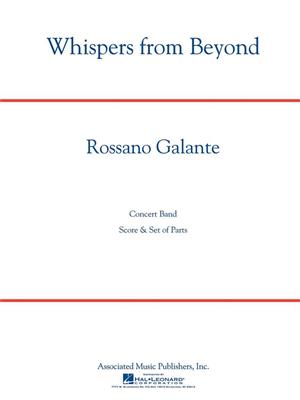Results
-
 £134.99
£134.99The Secret of Mercury - Jan de Haan
This work was commissioned by the concert band Da Capo Leeuwarden from the Netherlands, which was linked with the Dutch postal service PTT up until 1995. Mercury happens to be the messenger of the gods - a kind of mailman, one could say. Yet the composer did not choose the god but the planet Mercury as his source of inspiration for this work in four uninterrupted movements. He created a multifaceted work in which the mysterious celestial body is represented, as well as a number of space missions exploring it. This interesting subject matter guarantees a composition that fascinates from start to finish.
Estimated dispatch 7-14 working days
-
 £64.99
£64.99If It Were Easy... - Richard L. Saucedo
Composed as a tribute and memorial to a revered educator, If It Were Easy... brings to mind a range of emotions and moods, including the idea that goals worth achieving are not always easy, but require dedication and perseverance.The piece begins quietly then builds gradually to a glorious full band chorale before tapering to a quiet and delicate finish.
Estimated dispatch 7-14 working days
-
 £109.99
£109.99Tom Jones in Concert
Having scored many hits over a long career, especially in the sixties and seventies, Tom Jones remains a world star. Gilbert Tinner has now created a fantastic and easily playable arrangement with songs from this period. This medley includes She's a Lady, It's Not Unusual, Delilah and Help Yourself.
Estimated dispatch 7-14 working days
-
 £149.40
£149.40Bnsull i advent - Trygve Hoff
The composer and musician Trygve Hoff was born and raised at Rognan in Nordland and gained a lot of inspiration for his texts from the North Norwegian culture. He is a composer and copywriter of many of our most popular songs. "Ei hand holde i" and "Har en drm" with music by Svein Gundersen and especially his own "North Norwegian Christmas Psalm" are famous songs in Norway. "Lullaby in advent" may not be among his most famous songs, but it's a beautiful and thoughtful melody that will fit well with any Christmas concert. Hoff himself varied with musical styles on this song. This arrangement is written as a jazz-version with swing feel.
Estimated dispatch 7-14 working days
-
 £174.99
£174.99Fiori - Thomas Doss
Fiori finds its genesis in a walk through an impressionistic garden. It expresses not only the atmosphere and mood but also tiny and grotesque scenes between the insects. The flute, as a solo instrument, plays a perfect role in this marvellous micro world. It was a challenge for the composer to integrate the sound of the flute through the "fragrance of flowers and exotic plants that fills the air".
Estimated dispatch 7-14 working days
-
 £118.99
£118.99Cinderella - Patrick Doyle
Who doesn't know the famous Disney fairytale 'Cinderella'? Not only are the fantastic visuals in the animation movie impressive, the beautiful songs are too. Eiji Suzuki made a medley of Bibbidi Bobbidi Boo, The First Branch, Pumpkin Pursuit, Who Is She, Lavender's Blue and A Dream Is A Wish Your Heart Makes. A perfect choice for your audience!
Estimated dispatch 7-14 working days
-
 £127.30
£127.30Funky Hedde - Torstein Aagaard-Nilsen
A good friend of mine, trombonist and professor Jesper Juul Windahl commissioned me a trombone quartet. I then wrote Four Nordic Folk Pops. The last of the four is a Norwegian tune called Havard Hedde in a funky version. Then I made a brass quintet version for Lofoten Brass Quintet for a their Australia tour. The trombonist in the quintet asked me for a brass band version to be used in an entertainment contest (SIDDIS Brass). Havard Hedde did not succeed in getting married, but I think this version wil make him dance again. Torstein Aagaard-Nilsen
Estimated dispatch 7-14 working days
-
£168.50
Armed Forces - Larry Clark
With theme songs from all five branches of the armed forces, stirring march themes from John Philip Sousa, and both the Pledge of Allegiance and National Anthem of the United States of America, Armed Forces The Pride of America is sure to become a staple for patriotic programs. Arrangers Larry Clark and Greg Gilpin have taken great care in creating a uniquely flexible setting both in instrumentation and performance. Designed to be performed by band, orchestra, or chorus, separately or in any conceivable combination, ensembles need not be limited by size or instrumentation. Careful attention has also been paid to playability for ease of performance and rehearsal. An optionalending allows even further flexibility when performance time is a consideration and an optional narrator part can be used to invite rousing audience participation. This popular medley is sure to bring a stunning performance in almost any setting.
Estimated dispatch 7-14 working days
-
 £76.99
£76.99Whispers from Beyond - Rossano Galante
Composed as a tender tribute to a lost friend, this is meant not to be a mournful piece, but rather a joyous remembrance of a life ended too soon. The work features two primary themes that ebb and flow as the music progresses. Soaring melodic lines and rich orchestration help bring character and distinction to this effective and emotional piece. Dur: 4:00
Estimated dispatch 7-14 working days
-
 £66.95
£66.95In tantum lux - Todd Stalter
In tantum lux (The only light) was written as a memorial and celebration honoring the life of a music educator and her faith, who taught in a small school her entire career and persevered through the challenges and unique demands that teaching small school bands present. The piece also serves as a celebration of every band student and teacher in small schools everywhere who may not have the resources to have a full ensemble, yet strive every day to experience the joy of making music to the fullest just the same. (4:00)
Estimated dispatch 7-14 working days
